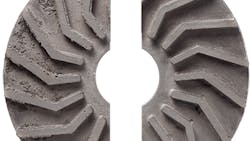How Penetration Defects Happen, and How to Prevent Them
A well-known preventative step to address penetration defects is to use a coating (Figure 1), though undoubtedly you’ve heard this before too. Yet, what makes a good coating? Rheology – a fancy R&D term – explains what separates and distinguishes a coating. In short, rheology describes the measurement/determination of a liquid/solid matter’s flowability.
What is flowability? This term is affected by the deformation of the liquid, as well as solid components. The deformation of matter is essentially a reaction at the impact of a specific force. Surely this all makes sense, right? Clearly I’m kidding. However, just know this, the effects of poor rheology will include: insufficient layer thickness, teardrops, runs, prolonged handling times, inhomogeneity, and problems with core prints. Ultimately, it’s very important to trust a supplier with reliable R&D resources and proven technical services. That way you’ll have the assurance of knowing you’re receiving a coating with the ideal rheology characteristics for your requirements.Now, let’s address the science behind a penetration defect.
Penetrations: Defect Pattern & Causes — Fundamental causes for real (mechanical/physical) penetration are metallostatic pressure, dynamic pressure during casting, and crystallization pressure during solidification.
Thus, penetration can occur as a function of the following influence factors: • The grain size of the mold material is too large and the grain particle size distribution is too broad; • The proportions of binder are too low.The proportion of materials that form lustrous carbon is too low;
• Unfavorable chemical composition of the casting material in combination with casting temperatures and metallostatic pressure that are too high;
• Inadequate and uneven compaction of the molds or cores; and
• Inadequate gating system and therefore excessive overheating of molds and core components
Join the Conversation. Email Your Questions for ASK Chemicals
Share your insights, opinions, and elaborate on the questions and the experts' answer(s). You must be logged in to the website in order to post your comments.

